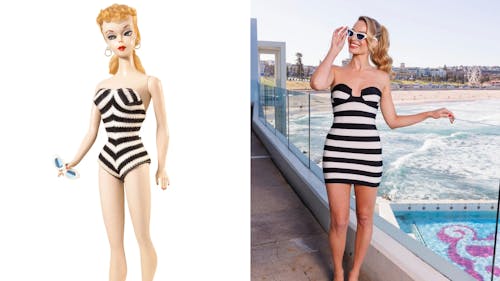KONDA: Generation Z consumers are obsessed with nostalgia
Column: Pitch in

I am nostalgic all the time. When I sit in my bedroom at home, staring at the dated posters on my walls and the old stuffed animals on my bed, I am reminded of the past. Maybe it is my childhood or my early teenage years, but it offers me a strange sense of comfort, something I cannot find anywhere else.
It reminded me of my confusion when the Y2K trend popped up out of nowhere, and I started seeing influencers wearing the same bootcut jeans I never thought looked remotely flattering. I have five pairs of them in my closet now, so you could say I was influenced.
But I never really experienced the early 2000s since I was born just around that time. My memory begins in 2009 when people shifted to a new 2010s style, which is the same for most of Generation Z. Their memories of that time either faded or never existed, raising the question of why trends from the past are so popular today.
Why is everyone nostalgic for a time before our time? What is there to reminisce about when it has not been experienced firsthand? Are we, perhaps, looking back to find a perception of life that seems simpler and somehow more exciting?
The idea of using a Nokia cell phone, wearing large-print graphic T-shirts and living in a less technologically advanced world is so popular, yet Generation Z refurbishes old trends by building atop its roots.
Fashion, for instance, is known to be cyclical in nature, repeating similar aesthetics and patterns to match the present time. The Y2K trend is an obvious tribute to the early 2000s, and its current reemergence in the 2020s exemplifies its initial cultivation.
A recession in the early 1990s led to an increase in minimalist style — after the excessive spending and consumerism of the 1980s — which was followed by a period of maximalism in the early 2000s, yet again. As the pandemic disrupted the world in 2020, Generation Z turned to nostalgia during the difficult time, bringing back this same 2000s culture.
Clare Varga, the director of beauty for the trend forecasting company WGSN, mentioned how the pandemic "shifted consumer needs significantly towards escapism and products that reminded them of better, more carefree times, as well as friends and places."
Although Generation Z has barely experienced the cultural trends of the late 1990s and early 2000s, we pick and choose the likable parts to add to our current culture. That is the beauty of nostalgia — getting to intertwine modern elements with an original background and offering a unique experience for consumers.
Companies have begun adopting strategies to remind their customers of the past through "nostalgia marketing." This tactic is done effectively by associating products with an iconographic memory from the past to trigger an emotional connection between buyers and the brand. For example, "Barbie," starring Margot Robbie as Stereotypical Barbie, took the world by storm in July by reminding audiences of the impact the doll had on most of their childhoods — a prime example of nostalgia marketing.
The Mattel dolls have been revolutionary to American culture for decades, dating back to 1959's original Barbie. The movie, serving as a reminder of a cultural icon, grossed more than $1.4 billion at the box office, making it one of the top-grossing films of all time.
Nostalgia marketing is more effective than introducing novel ideas to a specific industry. When we see something we are familiar with, like the Snoopy stuffed animal in a puffer jacket at CVS, we are more incentivized and interested in buying it.
A reimagined product that improves in quality while maintaining its authenticity is a powerful tool in today’s age.
This is an almost foolproof way for well-known, classic companies to boost their sales again. Watch out during the holiday season and look for signs of nostalgia that hit you without acknowledgment. Does that red sweater remind you of Christmas when you were 8 years old?
I know — your favorite childhood cartoon is starting to sell themed clothing, and you just have to get your hands on them. Maybe even the packaging on a Thanksgiving dinner ingredient has you thinking about your family’s history.
It is a fascinating combination of psychology and marketing. We like things we are familiar with — this is a fact for most people. There is a comfort associated with that brand we love over time, making us return to it without a second thought.
Vaishnavi Konda is a sophomore at Rutgers Business School majoring in business analytics and information technology and minoring in linguistics. Her column, "Pitch In," runs on alternate Sundays.
*Columns, cartoons and letters do not necessarily reflect the views of the Targum Publishing Company or its staff.
YOUR VOICE | The Daily Targum welcomes submissions from all readers. Due to space limitations in our print newspaper, letters to the editor must not exceed 900 words. Guest columns and commentaries must be between 700 and 900 words. All authors must include their name, phone number, class year and college affiliation or department to be considered for publication. Please submit via email to oped@dailytargum.com by 4 p.m. to be considered for the following day's publication. Columns, cartoons and letters do not necessarily reflect the views of the Targum Publishing Company or its staff.



